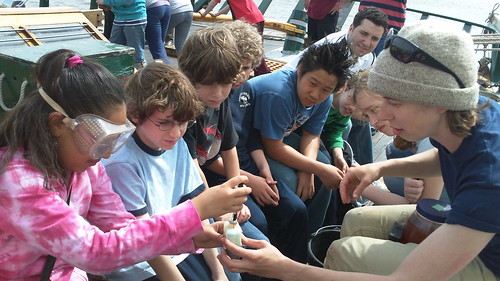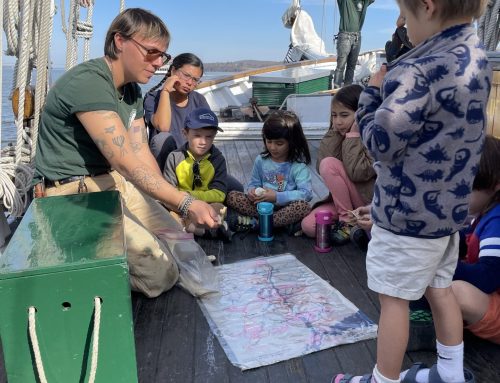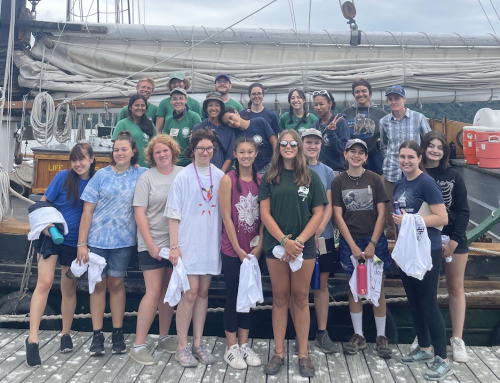Editor’s Note: Through the winter months, Clearwater educators – eager to teach, and learn! – will regularly post an Educator Blog covering the Hudson River from Lake Tear of the Clouds to the Battery in NYC . Dividing the river into 15 to 20-mile-long stretches, we will cover the entire river by the time we’re sailing again in April. Our tri-fold focus will cover Cultural History, Natural History, and Environmental Issues, and will include factoids and ponderables to stimulate the minds of even the most seasoned river lovers!

Scots Pine plantation. (Photo by Will Allen)
For this blog, Clearwater Onboard Education Specialist, Tom O’Dowd, is focuses on the camp where he worked for four summers, NY State Department of Environmental Conservation Camp Pack Forest, which sits on the banks of the Hudson River in Warrensburg, NY.
Natural History:
Camp Pack Forest takes place at the Charles Lathrop Pack Demonstration Forest, a property of SUNY ESF. It is made up of camp buildings (cabins, dining hall, office), a man-made lake (Lake Pack Forest), a small mountain, a series of beaver ponds and marshes, and a unique kettle bog habitat. The property extends at least a mile from the main buildings to the Hudson River itself. A huge part of the property is a plantation, once used for demonstrating forestry techniques to students of the NY State College of Forestry, the early name of SUNY ESF.
Tree plantations usually exist as a monoculture, a landscape managed to grow one species for economic purposes (lumber, pulp, etc.). Because trees are often planted at the same time, they compete for light, grow tall quickly, and have few lower branches. All of these characteristics make plantations good for business and less than desirable for other plants and animals. Think of a Christmas tree farm. (Live Christmas trees are still better than plastic ones, but decorating an existing houseplant is best!).
Pack Forest is a demonstration forest, meaning it is now used to instruct students of forestry at SUNY-ESF in forestry methods. The camp has a huge tract of land, broken up into a grid, where each square section is a different species of tree. There are a lot of squares of red and other pines. There are also a variety of logging road types and techniques, esp. water-bars that reduce run-off and mucky roads. Water bars channel water off the road while still allowing vehicles to pass, and can be made by digging ditches, laying logs or stones, or constructing bars with flaps of rubber sticking up.
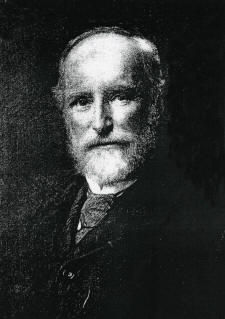
Geo.W. Pack , engraving by Bierstadt after the painting by Daniel Huntington, 1893
(Source: http://toto.lib.unca.edu/web_exhibits/WNC_pack/pack_default.htm)
Cultural History:
Pack Forest is named after Charles Lathrop Pack, a wealthy timberman–one of the five richest men before World War I (and known for his interest in stamp collecting!)—who donated this land to the (then-named) NY State College of Forestry. His body is buried beneath some White Pines (Pinus strobus) near the lake.
Pack came from a family of wealthy timbermen—his father and grandfather had created successful logging operations in the state of Michigan. His grandfather, George Pack, Jr., lived in central New York and became a lawyer and land owner before travelling with his wife and ten children down the Erie Canal, on a “side-wheeler” steamboat to Buffalo, through Lake Erie, to the banks of Lake Huron in Michigan. George Pack’s son, George Willis Pack (who was born and would die in New York state), would begin more timber operations, help others buy land in Michigan, serve on the board of regents for the University of Michigan, and come to be known as an abolitionist. He would go on to live in Asheville, North Carolina, and fund many public buildings and parks.
Charles Lathrop Pack was one of the first men to be trained in forestry (he studied in Germany). He also was one of the first foresters to be paid to evaluate forestlands (by Jay Gould, wealthy railroad developer). Charles was a forestry expert for President Roosevelt and served as President of several conservation, food security, and forestry organizations, including the National War Garden Commission and the American Forestry Association. The Pack Demonstration Forest is one of three he donated (the others for Yale and the University of Washington).
A WWF camp in Tuscany. (Source: Wikimedia).
Environmental Issues:
The future of the environment depends on the citizens of the future. The youth of today are the citizens of the future. That’s why Clearwater makes it our mission to create the next generation of environmental leaders. This is the heart of environmental education, and more specifically, place-based education. Participants in Clearwater’s “Classroom of the Waves” sail programs, tideline and in-class programs, Camp Clearwater, and our Youth Empowerment Programs get in touch with nature, their Hudson Valley, and their inner strengths all while bonding with peers and having fun. Environmental education is crucial to environmental protection.
Pack Forest and the other DEC Camps give us good examples of Environmental Education in action. The camps focus on environmental concepts (adaptation, diversity, energy flows, etc.) as well as caring about the environment (they have human impact lessons and solo time in nature). Students camp, hike, canoe, swim, play games, fish, and even have the chance to learn about hunter safety. At Pack Forest, there is even a wheelchair accessible interpretive trail, the Grandmother Tree Trail, which visits various forest and wetland habitats and the Grandmother tree herself via bridges, trails, and boardwalks. Once again, this kind of joyful access to nature is CRUCIAL to environmental protection…to creating the future environmental leaders.
Think about it. What caused YOU to become an environmentalist? A lot of research has been done on what makes a person care for the environment and work to protect it, and there are two things* that almost all adult environmentalists say led them to be environmentalists:
1) Positive experiences in nature as a child
2) An adult mentor who shares nature (and other fun times) with the child
* = sometimes being part of an environmental organization as a child is cited as the (distant) third most-important influence on future environmental behavior.
Perhaps experience with Clearwater can give students positive experiences on the river (wind in their faces, fishes in their hands) with positive role models (their teachers and the crew) and an organization that supports their activism (Green Cities initiative and Festival activities).
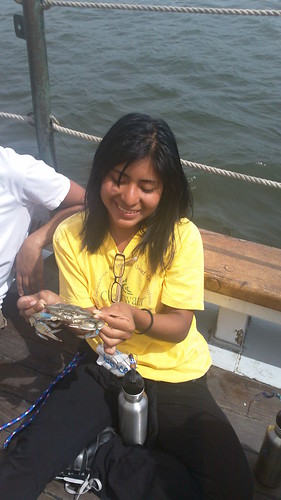
A Challenge for You:
Think about how you can bring nature into a child’s life. Can you bring them on a walk through the woods or skip rocks with them on the Hudson? Can you watch the moon at night with them or take them on a sail on the sloop Clearwater? Are you being a good role model, deliberately making everyday life choices based on environmental factors? If you are reading the Clearwater Educator Blog, you probably already care about the sloop’s mission to create the next generation of environmental leaders. So, thanks for reading, and please join us on our mission!
